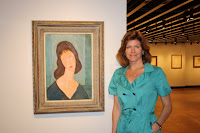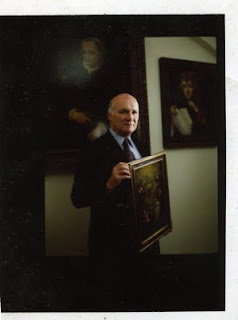Friday, September 30, 2011 -  certificates of authenticity,fakes and forgeries,South Africa,Toby Orford
certificates of authenticity,fakes and forgeries,South Africa,Toby Orford
 No comments
No comments
 certificates of authenticity,fakes and forgeries,South Africa,Toby Orford
certificates of authenticity,fakes and forgeries,South Africa,Toby Orford
 No comments
No comments
Forgery in South Africa: The Story of Frans Claerhout
 |
| A 'fake' |
by Toby Orford
Higher prices for art are an inevitable sign of emerging market maturity – and also widespread criminal activity. Although art dealers and auctioneers are discreet about the scope of the problem in South Africa, the sales of art attributed to the artist Frans Claerhout on an internet auction site is blatant evidence that art forgery is an ongoing problem that cannot be ignored or, it seems, stopped.
A Belgian Catholic missionary priest, Frans Claerhout, lived most of his life in the Orange Free State. From 1957 onwards – heavily influenced by Flemish expressionism - Claerhout painted a large number of landscapes and figures. Other media included drawings in charcoal, pen-and-ink and crayon.
In 2002 the artist belatedly acknowledged that a close family friend of 45 years had started independently to copy his work, without his knowledge or involvement, and that “hundreds” of forgeries had been sold as originals in well-known Bloemfontein art gallery.
Claerhout died in 2006. Several years later a suspiciously large number of works are being sold on South African internet auction – and private - websites. Anonymous sellers are advertising works at prices in the region of ZAR 3,000 (approx USD 375) to ZAR 7,000 (approx USD 875). As Artinsure (www.artinsure.co.za) has noted, in a clumsy attempt to manufacture credible provenance, paintings are accompanied by a “Certificate of Authenticity” and, on the back, a reproduction of a supposedly original message from the artist. Unfortunately, the pro forma message does not refer to the artwork to which it is attached - and is also false.
The quality of the work is inexplicably amateurish and inferior, and obviously inconsistent with the artist’s style, technique and imagery. Moreover, buyers have reported that paintings have arrived with fresh, wet – even smudged – paint, on board that only recently became available in South Africa.
Nevertheless, the tactic of selling fakes very cheaply on the internet has been quite successful. It has been reported that more than 30 such forgeries have been identified. The low prices are both a temptation and a warning. It is usually the less wealthy and less experienced purchaser that is deceived. Tempted by greed to “beat the market”, even those who suspect that they have been deceived probably don’t care. Or, for such a low outlay, they are prepared to take the risk – or to turn a blind eye to what is going on.
Cecile Loedolff, an art curator, said in 2002 that the Absa Bank Collection had decided a long time ago to stop buying Claerhout paintings:
" I don't touch a Claerhout ….. I find it very strange that nobody became suspicious earlier. In the last few years, Claerhouts have been issued at the speed of white light."
People are naturally concerned about the authenticity of anything attributed to Claerhout and this will always be bad news for the value of his art. This may explain why as recently as Monday 26 September 2011 several Claerhout paintings failed to sell at a major fine art auction in Cape Town.
The South African Police are investigating. Previous police investigations have failed and a lack of training, experience and resources means that criminal prosecutions are unlikely. Unfortunately www.bidorbuy.co.za/ is not taking any action, because (it says) it has yet to be presented with any “hard, factual evidence or proof” and has not been contacted by the authorities.
And so, nearly ten years later, the uncertainty, which some lamely predicted would “sort itself out”, continues. The general reluctance to confront and stop such obviously fraudulent activity is surprising.
Privately funded litigation might be the only way to break this vicious circle. Robert Badenhorst is an artist and gallery owner who agrees that Claerhout values have dropped. He is currently considering whether to overcome inertia and to organise a private investigation in order to collect the evidence that is necessary to prosecute the sellers. Civil litigation against them is also a possibility. Although the buyers who have been cheated want to recover their losses, the main objective of any legal action would be to “name and shame” – and stop the forgeries. This is necessary in order to protect Claerhout’s legacy. But it is also necessary to protect the reputation of South African art in general.
© Toby Orford 2011




















